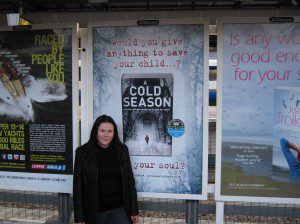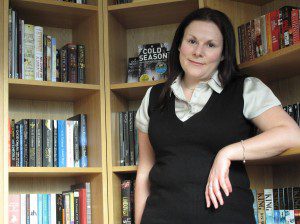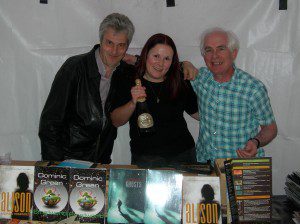In the first interview for Women in Horror Recognition Month, Alan Kelly puts questions to the bright and talented novelist Alison Littlewood about her occult-themed, lyrically beautiful, slow-burning chiller A Cold Season.
Featuring similar themes and iconography as genre classics The Wicker Man and Don’t Look Now, and channelling the malevolent energy of early Polanski. Alison’s outstanding first novel is one of the finest debuts published this year and marks her out as an important new voice in the canon of supernatural fiction.
Alison talks about her fictional town, the dark corner of nowhere Darnshaw, her investigations into occult practices and strange rural customs, how she became involved with Jo Fletcher Books and a strange circle of bones…
A Cold Season is reminiscent of both The Wicker Man and Nicholas Roeg’s Don’t Look Now. It features similar themes, iconography and ideas but is very much your story. Tell me where A Cold Season started?
AL: At the time I began writing the book I was living in West Yorkshire and commuting to Saddleworth, crossing the moors every day. There had just been a really bad winter during which the roads were often impassable. Sometimes when I did make it across the tops it became an adventure to make it back again – every route had its own hairy moments! Setting the novel in Saddleworth seemed the natural thing to do – I knew the area, which is always going to help, and it had the potential to isolate the characters as well as lending itself to a sense of eeriness. The images of the moors and countryside covered in snow were still very fresh in my mind.
I’d also been thinking about Faustian pacts, working through the logic of them on their own terms, and trying to work out what exactly would be worth it: surely not money, or status; even, really, someone else’s life. That speculation came together with the setting to make A Cold Season.
 Having grown up in a small town, how much of Darnshaw is fiction and how much is based on your own experiences?
Having grown up in a small town, how much of Darnshaw is fiction and how much is based on your own experiences?
AL: Darnshaw is really based on the small villages at the edge of Saddleworth Moor. I pictured it as being in the geographic location of Greenfield, though the actual places within the village – the mill, school, shops and so on – are invented. Moorfoot takes the place of Holmfirth on the other side of a long, winding moorland road, though I felt Holmfirth had too many Last of the Summer Wine connotations to appear under its own name! The witch stones are invented too, though I can’t help wishing they were real.
The mill itself is based on somewhere I lived some time ago, not too far away from the area. Now that really was in a small village, with little there except the mill, a school and a pub or two! We got snowed in there on several occasions, and it was a long walk to anywhere in particular (except the pub of course).
You studied English and History. Did you research occult practices or investigate strange rural customs as you wrote and if you did, would you share it with us?
AL: I did research witchcraft in the area, but really, little of that found its way into the book – it’s mainly invented. I did look into the Pendle witches, thinking I might use some of that history in the narrative, but decided in the end it took place too far away. Oddly enough, one specific thing that found its way into the text was an incident when I was walking near the mill where I used to live, when I found a circle of bones beside the path. Probably just some predator that had scattered them that way, but it seemed odd all the same, and must have stuck in my mind.
Having said that, when I was studying I did a terrific module on sixteenth century witchcraft and another on madness and writing – so perhaps I should have known back then I’d be drawn to the ‘dark side’ of fiction!
Grief is the driving emotion for your heroine Cass throughout the story, your description of the landscape was wonderfully sinister and evocative and really reflected where this woman was inside her own head. Sometimes in dark literature, a character needs damage to survive that descent into Hell. Would you agree?
AL: Absolutely. I suppose as writers we create a character and then push them, see how far they’ll stretch before they break! I don’t tend to plan a character too carefully in advance – it’s more a case of discovering who they are as they adapt and respond to the things that happen to them. And of course they come out changed – Cass has to dig deep and find more strength than she knew she had, and discover for herself just how far she’s prepared to go to protect her son.
Do you have a writing routine, how many words would you get down on a daily basis, do you map out scenes and chapters beforehand?
AL: I do try and be disciplined about it, though it doesn’t always go according to plan. I tend to think a minimum of 1,000 words a day is a good basic target, but I usually want to beat that and feel a little disappointed if that’s all I manage. I was made redundant just before I got the publishing deal, so I’m writing full time at the moment and need to up the word count. Having said that, a lot of my time has been spent on editing, editing, editing – so word counts can go up as well as down!
 I don’t plot things out in a lot of detail – I usually have a really clear idea of what I want the first few chapters to be, and roughly where I want to end up. Beyond the first 10,000 words or so, it gets a little hazy! I often wish I could plan more – it’d be a nice safety net to know where it was all going – but it just doesn’t seem to work for me that way.
I don’t plot things out in a lot of detail – I usually have a really clear idea of what I want the first few chapters to be, and roughly where I want to end up. Beyond the first 10,000 words or so, it gets a little hazy! I often wish I could plan more – it’d be a nice safety net to know where it was all going – but it just doesn’t seem to work for me that way.
Gary McMahon said that he’d love to see A Cold Season get the Hammer Horror treatment. Are there any filmmakers you’d like to see adapt it?
AL: A few people have asked me about A Cold Season as a film – who I’d like to star in it, and so on. When I imagine it as a film, though, I seem to just see certain images – one of the characters standing in the half-dark, letting snow fall onto his skin, seems to be the main one. Oddly, I can’t seem to think about who the actors or directors would be. Perhaps that’s because having it made into a movie seems such an exotic idea – albeit something I would absolutely love!
Your next novel sounds like a departure from A Cold Season.
AL: The next novel, Path of Needles, is going to be a twisted fairytale meets a crime story – so it is kind of a departure, but with the same dark threads and potential for the strange and unsettling as in A Cold Season. I used to adore fairytales when I was young – still do, really – and it explores the darker side of some of the stories we think of as familiar. This time the novel is set in springtime, and the locations are all near where I live. I had one very odd research trip recently to a nearby castle, where I was trying to work out how to get a body from the car park to the motte – such are the strange places writing leads you, I suppose!
How did you become involved with Jo Fletcher’s new imprint?
AL: To be honest I wasn’t exactly at a high-point confidence wise, and all I’d done with the manuscript at the time was query some smaller presses, who had uniformly refused to look at it (though in a kind way – they did tell me to try someone bigger first!).
Back in January 2011 I took part in a Twisted Tales event, and got chatting to Roy Gray, who handles events for TTA Press. He knew my work from Black Static magazine and suggested I sent the novel to Jo – he even emailed her the next day to see if she’d read it. Fortunately, she did – and everything seems to have moved very quickly since then!
Could you recommend some writers whose work you like and why
AL: I love Neil Gaiman’s novels, particularly American Gods – his use of mythology gives them a tremendous depth and richness, and they’re always beautifully formed. I’ve always enjoyed a good Stephen King, and Joe Hill is living up to the family tradition in spades – Heart Shaped Box and Horns are amazing. Graham Joyce writes sensitively and beautifully, and his characterisation is second to none. The Silent Land is a lovely book – it made me cry – and I love The Tooth Fairy. Dan Simmons is terrific for his sense of place – from Calcutta in The Song of Kali to the Arctic in The Terror, reading one of his novels is like being transported somewhere else.
Who are some women working in the genre who you’d like to bring to our attention?
AL: I love Sarah Langan’s novels. They’re tough, gritty and disturbing. Audrey’s Door in particular creeped me out no end! Liz Jensen’s The Rapture is a great read too. It revolves around a disturbed young girl with powers of premonition, who begins to foresee a series of environmental disasters. Kaaron Warren, an Australian writer, is a terrific talent – I really enjoyed Walking the Tree. Then there are Tanith Lee, Aliette de Bodard, Lisa Tuttle . . . Elizabeth Hand’s stories are incredibly unsettling too – the most recent I’ve read was Near Zennor. Really pleased to see it’s just been picked for the Year’s Best Dark Fantasy and Horror anthology (which is, incidentally, edited by a woman – Paula Guran – and any mention of female horror anthologists has to bring Ellen Datlow to mind).
ALAN KELLY
—
If you enjoyed our interview with Alison Littlewood and want to read more of her fiction, please consider clicking through to our Amazon Affiliate links and purchasing a new book today. If you do you’ll help keep the This Is Horror ship afloat with some very welcome remuneration.
Buy Alison Littlewood books (UK)Buy Alison Littlewood books (US)











